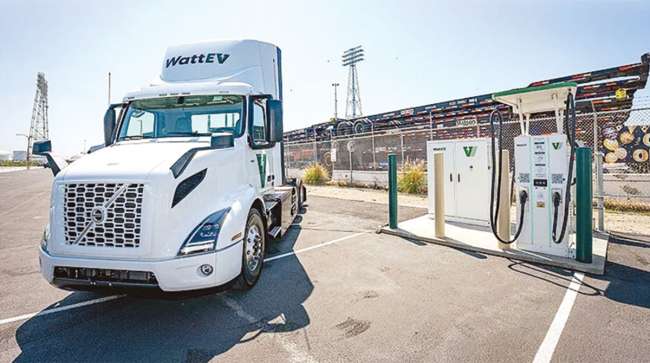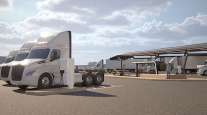Bloomberg News
Big-Truck Charging Has Private Money’s Attention

[Stay on top of transportation news: Get TTNews in your inbox.]
Hundreds of millions of dollars in grants awarded by state and federal programs have helped spur an influx of spending to develop EV chargers for the heaviest U.S. trucks.
Greenlane Infrastructure — the $675 million joint venture between Daimler Truck North America, NextEra Energy Resources and a BlackRock Inc. fund — just broke ground on the flagship site of the 280-mile commercial charging corridor it’s planning between Los Angeles and Las Vegas. TeraWatt Infrastructure Inc., which has raised more than $1 billion from investors including Vision Ridge Partners, is building a network of heavy-duty charging stations connecting California’s Port of Long Beach to El Paso, Texas. WattEV, backed by Apollo Global Management Inc. and Vitol, already operates several charging depots and has 15 more “grant-funded and shovel-ready covering the entire West Coast,” said Salim Youssefzadeh, WattEV’s CEO.
“We’re seeing industry making bigger investments,” especially as projects move beyond the pilot stage, said Erika Myers, executive director of Charging Interface Initiative North America, an advocacy group whose members span the entire EV charging supply chain from energy companies to automakers. There’s a lot of recent “excitement and enthusiasm for the development of electrification in the medium- and heavy-duty space.”
For countries and states looking to cut their carbon footprints, electrifying the medium- and heavy-duty transport sector probably looks like a no-brainer: These larger trucks produce almost one-quarter of the U.S. transportation sector’s greenhouse gas emissions despite accounting for just 5% of vehicles on the road.
We are excited to share the groundbreaking of our flagship zero-emission commercial EV charging and hydrogen-refueling station in Colton, CA! 🚛⚡ A historic milestone in sustainable transportation, the ceremony took place on the along the I-15 Corridor in southern California. pic.twitter.com/BKOBuPMSud — Greenlane Infrastructure (@Drive_Greenlane) September 9, 2024
But uptake across the U.S. has been slow, with BloombergNEF calling the U.S. market a global “laggard” in decarbonizing its commercial fleets. Medium- and heavy-duty trucks made up around 6% of electrified commercial vehicles sold in the U.S. in June, the latest data shows. Fewer than 1,000 of the zero-emission trucks were sold in the U.S. in the entire first half of 2024.
TT's Seth Clevenger and Erika Voss of DAT Freight and Analytics discuss crucial strategies and best practices for safeguarding information and assets in a high-demand period. Tune in above or by going to RoadSigns.ttnews.com.
A classic chicken-and-egg conundrum is largely at fault: Some manufacturers have been slow to produce bigger electric trucks, citing a lack of charging infrastructure, but who wants to build chargers for a commercial EV fleet that doesn’t yet exist? An overtaxed power grid that’s already stretched thin from AI demand isn’t helping either. And the trucks themselves can be expensive, particularly for drivers who already have a working diesel-powered option. On top of all that, it’s unclear whether any state and federal policies directed at the sector could come under fire following November’s presidential election, according to a BNEF analysis.
The market may soon be reaching an inflection point, with more electric trucks likely to hit the road this decade so long as the charging infrastructure can keep pace. A white paper from the International Council on Clean Transportation estimates there will be around 1.1 million zero-emission trucks in Classes 4 to 8 in 2030, up from just a few thousand today, buoyed by California state targets and federal funding unleashed by the Inflation Reduction Act. Activity is picking up in Washington, too, with the Biden administration now seeking input from stakeholders about charging technologies for medium- and heavy-duty vehicles after releasing in March a road map for electrifying longhaul trucking. Tesla Inc., which delivered its first electric Semi trucks to customer PepsiCo Inc. in 2022, is just one of the big-name companies looking to grow in the nascent market.
Planning to go big with EV charging? Don't wait! To have a state-of-the-art facility up and running by 2026, the time to act is now.
Partner with us and let's lead the future of sustainable transportation together. #VolteraPower #EVCharging #SustainableFuture pic.twitter.com/3lFa1lPThQ — Voltera (@volterapower) August 7, 2024
Given that potential growth outlook, private money is giving the sector a good, hard look. Private equity group EQT AB, for instance, which backs charging-infrastructure developer and operator Voltera, is not putting a cap on how much it plans to invest in the company, said Erwin Thompson, a partner at EQT Partners. Last month, Voltera secured a $100 million debt facility from units of ING Group NV and Investec Plc, which comes in addition to about $100 million so far from EQT’s infrastructure group.
“Any business that we invest in, you want make sure that you’re selling a growth story; you’re not selling something that’s a fully picked fruit tree,” Thompson said in an interview. “Forecasting to 2028-2029, I have full conviction that things will be well on their way.”
Want more news? Listen to today's daily briefing below or go here for more info:





